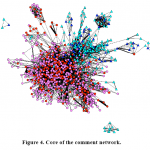Social Networking Data Mining and Genomic Sequencing Halts Tuburculosis Outbreak Spread
Posted on February 28, 2011 by Jeffrey Newman
A growing outbreak of tubruculosis in British Columbia, which could have expanded to other nations was deciphered and controlled as a result of a unique melding of social media data mining and human genome sequencing of the actual TB DNA. The findings, to be published today in the New Englnd Journal of Medicine are expected to help medical researchers in many other areas of medicine and science. Between 2006 and 2008, public health workers in BC, looking at health records, found 41 cases of TB which was a 10% increase in incidence. The question faced by the BC Centre for Disease Control was what was the source and how did it spread. Researchers sequenced the genomes of 36 bacterial samples from patients and then used special algorithms to compare mutations that arose in the microbes DNA as they spread. It showed two lineages of the microbe showing there had been two separate outbreaks that were independent from one another. This suggested an environmental rather than genetics factor. Then the researchers questioned patients about the people they lived and worked with as well as behaviors that might be contributing to the outbreak. Finally, they used a computer program to look for correlations and overlayed the genetics data showing the pattern of the genetic mutations with the info from the social net and they ultimately concluded that the outbreak was linked to an increase in crack cocaine. The main author is Patrick Tang, a medical microbiologist at the BCCDC. (MIT Technolofy Review source)
as a result of a unique melding of social media data mining and human genome sequencing of the actual TB DNA. The findings, to be published today in the New Englnd Journal of Medicine are expected to help medical researchers in many other areas of medicine and science. Between 2006 and 2008, public health workers in BC, looking at health records, found 41 cases of TB which was a 10% increase in incidence. The question faced by the BC Centre for Disease Control was what was the source and how did it spread. Researchers sequenced the genomes of 36 bacterial samples from patients and then used special algorithms to compare mutations that arose in the microbes DNA as they spread. It showed two lineages of the microbe showing there had been two separate outbreaks that were independent from one another. This suggested an environmental rather than genetics factor. Then the researchers questioned patients about the people they lived and worked with as well as behaviors that might be contributing to the outbreak. Finally, they used a computer program to look for correlations and overlayed the genetics data showing the pattern of the genetic mutations with the info from the social net and they ultimately concluded that the outbreak was linked to an increase in crack cocaine. The main author is Patrick Tang, a medical microbiologist at the BCCDC. (MIT Technolofy Review source)
